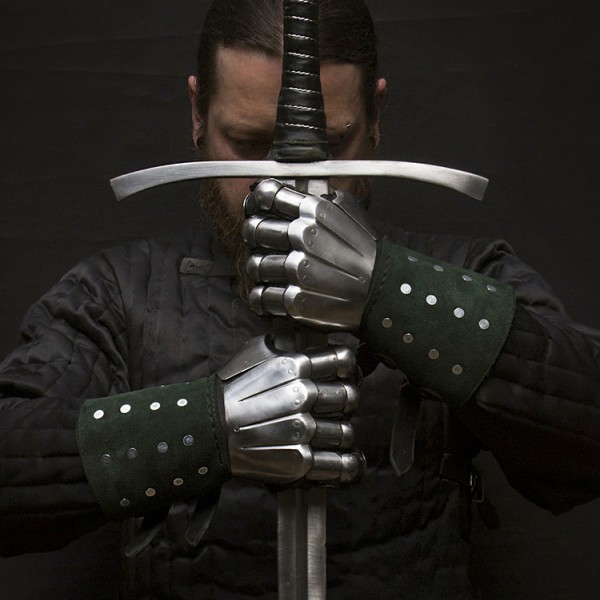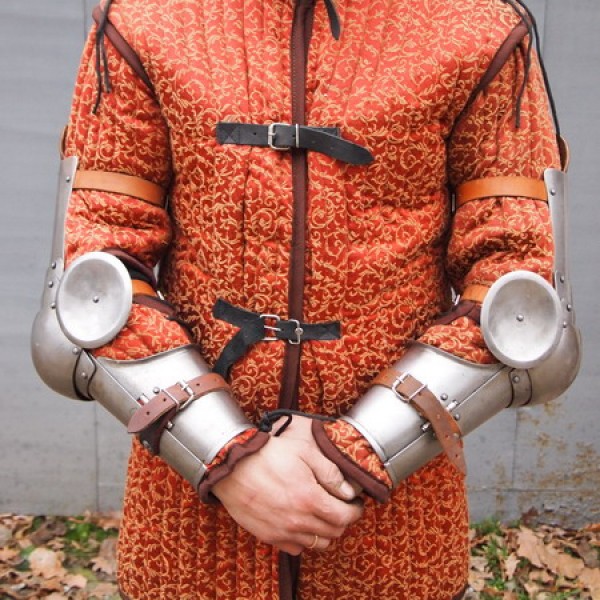Arm Armor
Our Splinted Arm Protection is based on armor from the XIV century. We craft it from 1.5mm cold rolled steel and durable 4mm brown leather. To increase the protective properties of the leather it is treated with a special wax solution and can withstand axe blows. The leather we use is naturally flexible and the reinforcing steel
Brigandine armor is composed of plates riveted to cloth or leather. This type of armor design was really popular and common in Medieval Europe. Obviously, it was much easier (and cheaper as well) to use pieces of iron or steel than to shape a flat sheet of metal. Images of brigandine type spaulders can be
Our Brigandine Arms are completed with steel elbow cops and the plates are made of 1.5mm cold rolled steel. Each plate is covered by the black paint on both sides to provide additional protection against rust (with the exception of the elbow cops which on painted on the interior only). The inner material is canvas,
Gauntlets with metal plates were first mentioned in the last decade of the XIII century. Before this, gloves were made of leather soaked in wax and were reinforced by iron, steel or brass plates. The construction of brigandine gauntlets of this period was similar to the way a coat of plates was made. Steel plates
Our Brigandine Arms with Splinted Segments consist of biceps, articulated elbows, vambraces (brassards) which are reinforced with steel plates. The perfectly articulated elbows are riveted to the arms – no holes, no leather laces. The upper arms have leather points that allow you to affix the armor to your gambeson. Our Brigandine Arms are equipped
Gauntlets without separate fingers were developed during the early XV century. The idea was to create good protection for the palm in which four fingers would be covered by one large steel plate. This type of armor was called Mitten Gauntlets, Hentzen (German), mitons (French), ormittene (Italian). They were commonly used both on battlefields and
Possessed of a tapered wrist that widens at the elbow, “tulip” shaped brassards were popular during the XIV and beginning of the XV century. The main examples of this type of arm armor can be found in Churburg Castle (Castel Coira) in South Tirol as well as the arms of Charles VI (made when he
Our Basic Steel Arms Set is a complete arm harness that protects your arms from the top of shoulder to the wrist joint. It consists of spaulders cups, steel bicep plates, elbows caps and vambraces. This armor has good mobility and it can be easily taken apart to reduce space requirements for storage and transportation.
This set of steel arms includes elbow cops with rondels and is secured with leather straps and steel buckles. This set provides you excellent mobility for both melées and duels. It is painted on the inside to provide additional protection against rust. Our base option for this set is 1.5mm cold rolled steel which can
Our Steel Arms set is made of 1.5mm cold rolled steel (other thickness and material options are available). It provides protection from the wrist to the lower shoulder. With the help of leather belts and steel buckles it’s very comfortable to wear with other parts of armor and can be donned quickly and easily. It’s
In the middle ages the fortress of Chalcis was a venetian colony. In 1470 it was destroyed by Ottoman Empire. The large hoard of fourteenth- and fifteenth-century armor was discovered in the ruins of the fortress in 1840. The Italian spaulders from the Chalcis armor collection dated from ca.1380 – 1400. Our Spaulders Chalkis consist
Medieval Arm Armour
The topic of arm protection is particularly interesting and is a pertinent topic to armor smiths and armored fighters alike. Crafting and wearing arm armor is not as simple as saying “Well, you need full arm armor, which consists of shoulder armor, rerebraces, elbow armor, and vambraces.” Before you purchase your set, you need to understand the purpose of your arm armor. In one instance, you might need armor to protect you during the buhurt. In another, you’ll need a good articulation because you’re planning on participating in HMB or IMCF duels. In both cases, you need armor for your arms, but your approach will differ based on your goals and needs.
Show more...
First of all, let’s walk through the main parts of armor for arms and take a closer look at their details. Arm protection starts with shoulder armor. We recommend paying special attention to this part, because shoulders are the most vulnerable to impact and often get hit. Good shoulder armor can and should withstand both sword and halberd. Consider the thickness of this armor segment – while 1mm metal thickness is enough for dueling, you will need 1.5mm thickness for buhurt.
Bicep armor and vambraces typically have a metal thickness of 1mm, which is enough for both buhurt and duel. However, of course, you should also consider your personal preferences and take care of your health.
Moving on to elbow armor – it is almost always 1.5mm thick. This thickness is due to a technical part of production. But don’t worry, it doesn’t affect the overall weight of your arm armor. When we’re talking about the armor’s weight, it’s important to understand that your arms should be as lightweight as possible. Your arms move the most during the battle, and even 100 grams of additional weight can affect your stamina, which is crucial for you and your team. Don’t let anyone down and reduce the weight of your arm armor as much as possible (but as always, safety first!).
According to HMB and IMCF regulations, you can use armor from the XIII – XV centuries. In the XIII century, armored European fighters mostly used brigandine arms and other simple armor to protect their arms. However, by the XV century, metal plates appeared that connected the armored elements for the shoulders, biceps, elbows, and forearms. Naturally, a structure connected with rivets offered more protection, but arm armor that was laced together offered a lot more mobility.
The issue of aesthetics and personal taste cannot be overlooked either. By opting for brigandine arm armor, you can choose from a large assortment of fabrics to cover your armor. It can be monochrome wool with a large selection of colors, or tapestry fabric just like you’ve seen in paintings at a museum. It’s also worth mentioning that the metallic parts of these pieces of battle equipment are painted over on both sides, which removes the need for care to some extent. Nevertheless, you can always choose a non-corrosive material and get so-called “white armor” which doesn’t use fabric or leather, except for straps, of course.
Don’t delay your dreams – purchase your arm armor today! If you have any questions – ask away. We’re always glad to talk about medieval battles and armor.
less..













 Shop
Shop